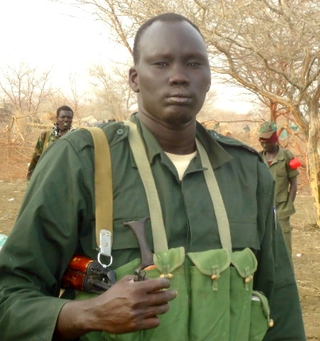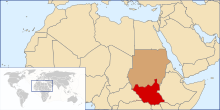
Jonglei State is a state of South Sudan with Bor as its centre of government and the biggest city. Jonglei state comprises nine counties: Bor, Akobo, Ayod, Uror, Duk, Nyirol, Pigi, Twic East, and Fangak. Jonglei State is the largest state by area before reorganisation, with an area of approximately 122,581 km2, as well as the most populous according to the 2008 census conducted in present-day South Sudan's second period of autonomy. The boundaries of the state were again changed as a result of a peace agreement signed on 22 February 2020.

Gabriel Gatwech Chan, more commonly known by the nickname Tang-Ginye or Tanginye meaning "long pipe", was a Nuer and a commander in various primarily Nuer rebel militias in South Sudan. General Tanginye led a southern border militia allied to the Khartoum government during Sudan's civil war. Members of the Sudanese armed forces loyal to Tanginye in Malakal clashed with the Sudan People's Liberation Army (SPLA) in 2006, killing about 150 people, and in 2009 in breach of the peace deal. In April 2011, clashes between his militia and the SPLA in the state of Jonglei killed at least 57 according to government officials. Shortly thereafter, Tanginye surrendered to SPLA forces and was placed under house arrest in Juba awaiting charges against him. During the South Sudanese Civil War, he allied with the SPLA-IO and later Lam Akol's militia, a Juba linked rebel group called the National Democratic Movement (NDM) and became its chief of staff. In January 2017 he visited a NDM-allied group, the Tiger Faction New Forces, in the Hamra area in the northern Upper Nile. In course of this visit, the Tigers were attacked by SPLM-IO-affiliated fighters belonging to the militia of John Uliny, and Tanginye was killed alongside most of the Tigers.
Peter Gatdet Yak or Peter Gadet was a Sudan People's Liberation Army (SPLA) general who became the leader of the South Sudan Liberation Army (SSLA), a rebel movement in South Sudan.

Fangak County is an administrative area in Jonglei State, South Sudan, with headquarters in the town of Phom el Zaraf.
Major General Yohannes Yual Both was a leader of the South Sudan Defense Forces whose mobile forces gave the Sudan People's Liberation Army considerable difficulty during the Second Sudanese Civil War (1983–2005).
Fangak is a community in South Sudan. It lies in Fangak County in Jonglei state. The capital is Old Fanguk. It was once a British garrison town. The administration buildings were destroyed during the civil war.
Ethnic violence in South Sudan has a long history among South Sudan's varied ethnic groups. South Sudan has 64 tribes with the largest being the Dinkas, who constitute about 35% of the population and predominate in government. The second largest are the Nuers. Conflict is often aggravated among nomadic groups over the issue of cattle and grazing land and is part of the wider Sudanese nomadic conflicts.
The South Sudan Democratic Movement (SSDM), sometimes called the South Sudan Democratic Movement/Army (SSDM/A), was a South Sudanese militant group. Along with its armed wing, the South Sudan Defence Army (SSDA), rebelled against the government of South Sudan led by President Salva Kiir Mayardit and the Sudan People's Liberation Movement.

The Nuer White Army, sometimes decapitalised as the "white army", is a semi-official name for a militant organisation formed by the Nuer people of central and eastern Greater Upper Nile in modern-day South Sudan as early as 1991. According to the Small Arms Survey, it arose from the 1991 schism within the Sudan People's Liberation Movement/Army (SPLM/A) for the dual purpose of defending Nuer cattle herds from neighbouring groups and fighting in the Second Sudanese Civil War between the SPLM/A and the Sudanese government.

David Yau Yau was a Governor of Boma State and the Chief Administrator of the Greater Pibor Administrative Area of South Sudan. He was previously the leader of a Murle insurrection against the South Sudanese government.

The South Sudanese Civil War was a multi-sided civil war in South Sudan between forces of the government and opposition forces. In December 2013, President Kiir accused his former deputy Riek Machar and 10 others of attempting a coup d'état. Machar denied trying to start a coup and fled to lead the SPLM – in opposition (SPLM-IO). Fighting broke out between the Sudan People's Liberation Movement (SPLM) and SPLM-IO, igniting the civil war. Ugandan troops were deployed to fight alongside the South Sudanese government. The United Nations has peacekeepers in the country as part of the United Nations Mission in South Sudan (UNMISS).

The Sudan People's Liberation Movement-in-Opposition, also known as the anti-governmental forces (AGF), is a mainly South Sudanese political party and rebel group that split from the Sudan People's Liberation Movement in 2013, due to political tensions between President Salva Kiir and Vice President Riek Machar over leadership of the SPLM. Tensions grew between forces loyal to Kiir and Machar and South Sudan plunged into the South Sudanese Civil War.
John Uliny, also known as Johnson Olony, Johnson Olonyi, and John Olony, is a South Sudanese militia leader. He is a member of the Shilluk ethnic group. He has at various points in time been allied with the South Sudan Democratic Movement, the Sudan People's Liberation Movement-in-Opposition and has led his own Agwelek Forces. He fought the South-Sudanese governement in Upper Nile State between 2016 and 2018.

The Greater Pibor Administrative Area is an administrative area in South Sudan.
Peter Par Jiek was a brigadier general of the Sudan People's Liberation Army (SPLA), and veteran of the Second Sudanese Civil War. In the course of that conflict, Par fought under Riek Machar with several rebel and pro-government groups, and eventually became a powerful militia commander in Unity State. In that region, he established his own fiefdom and gained some notoriety for his rivalry with another rebel leader, Peter Gadet. Even though he had followed Machar during the whole Second Sudanese Civil War until 2005, Par sided with President Salva Kiir Mayardit upon the outbreak of the South Sudanese Civil War in 2013. Leading pro-government counter-insurgency forces in Wau State since 2014, Par was eventually ambushed and killed by SPLM-IO rebels loyal to Machar in 2017.
The 2014 retreat from Western Bahr el Ghazal, also called the long march north, was an unorganized withdrawal by hundreds of Nuer Sudan People's Liberation Army (SPLA) deserters who sought to flee from Bahr el Ghazal to Sudan during the South Sudanese Civil War. After longstanding tensions between SPLA soldiers belonging to the Dinka and Nuer ethnic groups escalated on 25 April 2014, leading to a massacre of Nuer soldiers at Mapel in Western Bahr el Ghazal, a large number of Nuer SPLA soldiers deserted to escape ethnic prosecution and loyalist SPLA forces. Though some deserters joined SPLM-IO rebels or surrendered to the government, a large number of them marched northward, joined by other SPLA defectors from Northern Bahr el Ghazal. After covering over 400 kilometres (250 mi), this trek eventually arrived in Sudan on 4 August 2014, where they were disarmed.

The Ethiopian Unity Patriots Front is a political party and militant rebel organization that waged an insurgency against the Ethiopian government from 1993 to 2012. Formed by ex-officials of the Derg regime, the EUPF was mostly active in Ethiopia's Gambela Region as well as eastern Sudan and South Sudan. The group agreed to a ceasefire with the Ethiopian government in 2012, and officially ended its insurgency in 2016. The EUPF remains active, however, and its armed wing has reportedly been involved in the South Sudanese Civil War, although to what extent is disputed.
The War of the Peters was a conflict primarily fought between the forces of Peter Par Jiek and Peter Gadet from June 2000 to August 2001 in Unity State, Sudan. Though both were leaders of local branches of larger rebel groups that were involved in the Second Sudanese Civil War, the confrontation between the two commanders was essentially a private war. As Par and Gadet battled each other, the Sudanese government exploited the inter-rebel conflict as part of a divide and rule strategy, aimed at weakening the rebellion at large and allowing for the extraction of valuable oil in Unity State. In the end, Gadet and Par reconciled when their respective superiors agreed to merge the SPDF and SPLA.
The disarmament of the Lou Nuer was a forcible disarmament campaign undertaken by the SPLA in Southern Sudan in December 2005. While other groups had been peacefully disarmed, the Lou section of the Nuer in Northern Jonglei State refused to comply. The SPLA organized a force under Peter Bol Kong to forcibly disarm the Lou Nuer, whose White Army resisted until a defeat in the battle of Motot, after which they fled the area.

Elections were held in Jonglei State on 10–15 April 2010 as part of the 2010 Sudanese general election, with voting for President of Sudan, National Assembly of Sudan, President of Southern Sudan, Southern Sudan Legislative Assembly, Governor of Jonglei State and the Jonglei State Legislative Assembly. The elections were the first in Sudan for over two decades, held in the aftermath of the 2005 Comprehensive Peace Agreement between the Sudan People's Liberation Movement (SPLM) and the Government of Sudan of Omar al-Bashir. The election was carried out in precarious security conditions, with ethnic conflicts prevalent in the state. The elections were won by the SPLM, with the exception of a handful of seats. Disputes over the election results led to the outbreak of two armed insurgencies.












